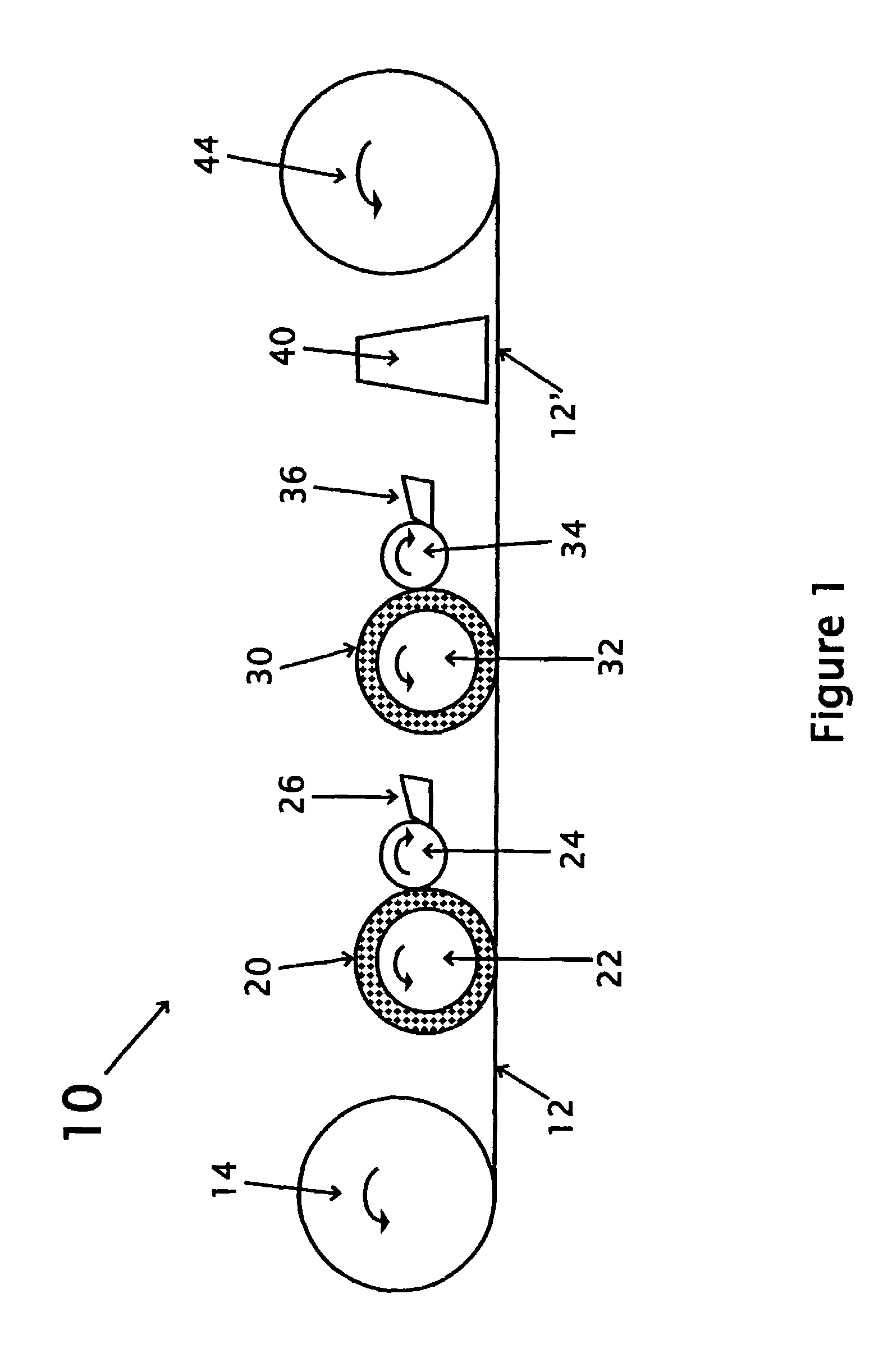Method for correcting print repeat length variability in printed extensible materials and product
a technology of printed extensible materials and product, applied in the field of flexographic printing, can solve the problems of printing on polymer film and other extensible materials that can present challenges, material close to the roll core may experience a great deal of tension, and printed extensible materials to vary significantly in print repeat length
- Summary
- Abstract
- Description
- Claims
- Application Information
AI Technical Summary
Benefits of technology
Problems solved by technology
Method used
Image
Examples
example 1
[0075]A polymer film composed of approximately 47% LLDPE, 4% LDPE, 45% ground calcium carbonate, and 4% minor ingredients (process aids, colorant, and antioxidant) is cast-extruded into an embossed film. The film is approximately 2 mils thick. The fresh film is printed with a standard, repeating print pattern at a PRL in the range of 300 to 600 mm. The snapback for this material is anticipated to be 1% of the given PRL. The printed material is then slit and wound into rolls containing approximately 10,000 lineal meters of film. The PRL of the freshly extruded and printed film is measured. The film is then set aside to age for predetermined intervals over several weeks.
[0076]After aging for predetermined intervals, the film is unwound, and the PRL of the aged material is measured. The PRL variability is plotted at a given age for the film for the position on the roll in lineal meters, where 0 is the outer surface of the roll and 10,000 is the core of the roll. The PRL variability of ...
example 2
[0077]A polymer film as described in Example 1 is prepared. The fresh film is printed with a standard print pattern at a PRL in the range of 300 to 600 mm. However, the tension of the film in the printing zone is controlled to compensate for the PRL variability noted in Experiment 1. The film is then slit and wound as in Example 1.
[0078]After aging for 21 days, the film is unwound and the PRL of the aged material is measured. The PRL variability of the aged film is plotted for the position on the roll, and shown in FIG. 8. As can be seen, the PRL variability is greatly reduced and the film has an essentially constant PRL near the target value.
example 3
[0079]A polymer film as described in Example 1 is prepared. The fresh film is printed with a standard print pattern at a PRL in the range of 300 to 600 mm. However, the RLM computer is programmed to adjust the press controller to vary the PRL of the freshly printed film to compensate for the PRL variability noted in Experiment 1. The film is then slit and wound as in Example 1.
[0080]After aging for 21 days, the film is unwound and the PRL of the aged material is measured. The PRL variability of the film is plotted for the aged roll, and shown in FIG. 9. As can be seen, the PRL variability is greatly reduced and the film has an essentially constant PRL near the target value after the PRL adjustment was applied at the press to the freshly printed film.
PUM
| Property | Measurement | Unit |
|---|---|---|
| thickness | aaaaa | aaaaa |
| length | aaaaa | aaaaa |
| length | aaaaa | aaaaa |
Abstract
Description
Claims
Application Information
 Login to View More
Login to View More - R&D
- Intellectual Property
- Life Sciences
- Materials
- Tech Scout
- Unparalleled Data Quality
- Higher Quality Content
- 60% Fewer Hallucinations
Browse by: Latest US Patents, China's latest patents, Technical Efficacy Thesaurus, Application Domain, Technology Topic, Popular Technical Reports.
© 2025 PatSnap. All rights reserved.Legal|Privacy policy|Modern Slavery Act Transparency Statement|Sitemap|About US| Contact US: help@patsnap.com



